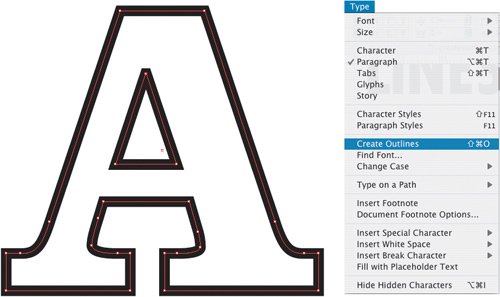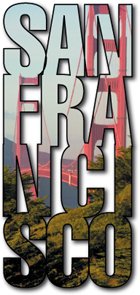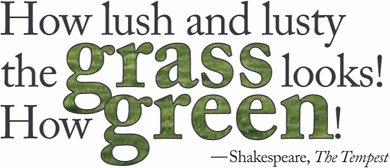Custom Type with Create Outlines
Need to customize a letter shape? Turn your type into outlines, and, with your Direct Selection tool, you'll be able to adjust the individual anchor points of the characters. Letters with counters (the trapped space inside the letters) or dots (lowercase "i" and "j") are compound paths because they consist of more than one path. In order to selectively modify their component paths, you first have to release the existing compound path: Object > Compound Paths > Release (Cmd+Option+8/Ctrl+Alt+8).
Figure 18.9. Choosing Create Outlines converts your type to an editable path shape.

Figure 18.10. Customized Letter Shapes.

Compound Paths
Compound paths are needed when two path shapes overlap and you want the top shape to punch a hole through the shape beneaththe "bagel" effect. For type, compound paths are necessary to create characters with counter shapes. You can also create custom compound paths for logo-style artwork that plays on the negative space created by overlapping shapes.
Note
If you want to create overlapping effects with color, use the Transparency effect below.
- Type you text and kern/position as necessary so that the characters overlap.
- Choose Type > Create Outlines to convert the type to paths.
- Before you make the combined letter shapes into a compound path, you'll need to first Choose Object > Compound Paths > Release to release any existing compound paths for characters with counters. This will cause the counters to become filled in.
- With your Direct Selection tool. select on a character-by-character basis the character and its counter, and choose Object > Pathfinder > Subtract to "knock out" the counter.
- Select all the character shapes and choose Object > Compound Paths > Make. The text path is cut away where it overlays the underlying object, revealing whatever lies beneath the background object.
Figure 18.11. Compound Paths.

Type Masks
When executed well, this can be an especially effective technique, making the type serve as letter-shaped windows to your image. Again it works best with bold sans serif typeallowing you to see more of the image and allowing you to kern the type closely so that the image retains continuity from one "type window" to the next.
- Arrange your type on top of an image and kern appropriately.
- In order for type to function as a picture frame for an image, it must first be converted to outlines. Choose Type > Create Outlines.
- Select the image and choose Edit > Cut (Cmd+X/Ctrl+X) to cut it into memory.
- Choose the type shapes and choose Edit > Paste Into (Cmd+Option+V/Ctrl+Alt+V).
- Use the Direct Selection tool to move the image around within the type shapes.
Figure 18.12. Type Mask. The type is stacked vertically to accommodate the image. Because the letters overlap, it is necessary to first merge the letter shapes using Object > Pathfinder > Add. To improve the definition of the letter shapes, I have added a black stroke to the letters.

Figure 18.13. Type applied as a texture. "Grass" and "Green" are selected with the Type tool and converted to outlines (making them into inline picture frames) before the grass image is Pasted Into each.

Path Type |
Part I: Character Formats
Getting Started
- Getting Started
- An InDesign Type Map: Where to Find Stuff
- Viewing Your Page
- Creating a Typography Workspace
- Up Next
Going with the Flow
- Going with the Flow
- A Blank Sheet: Typing on Your Page
- Text Flow
- Threading Text Frames
- Using Placeholder Text
- Pasting Text
- Importing Word Text
- Up Next
Character Reference
- Character Reference
- Less is More, Maybe
- Type Anatomy
- Type Classification
- Character Formatting Options
- Readability
- Up Next
Getting the Lead Out
- Getting the Lead Out
- How Much Is Enough?
- (Not) Using Auto Leading
- Keep It Consistent, Except. . .
- Leading Menu Options and Keyboard Shortcuts
- See Also
- Up Next
Kern, Baby, Kern
- Kern, Baby, Kern
- When to Kern
- Metrics Kerning
- Optical Kerning
- Manual Kerning
- How Much to Kern
- Tracking
- When to Track
- Controlling Widows and Orphans
- Up Next
Sweating the Small Stuff: Special Characters, White Space, and Glyphs
- Sweating the Small Stuff: Special Characters, White Space, and Glyphs
- Typographers Quotes
- Apostrophes
- Dashes
- Ellipses
- End Marks
- White Space Characters
- The Glyphs Palette
- Footnotes
- Footnote Options
- Up Next
OpenType: The New Frontier in Font Technology
- OpenType: The New Frontier in Font Technology
- Ligatures
- Discretionary Ligatures
- Ordinals/Raised and Lowered Characters
- Swash Characters
- Fractions
- Oldstyle Figures
- Contextual Alternates
- Opticals
- Glyph Positioning
- Stylistic Sets
- Up Next
Part II: Paragraph Formats
Aligning Your Type
- Aligning Your Type
- Centering Type
- Clean Shaven or Rugged: Justified vs. Ragged Type
- How InDesign Justifies Type
- Balancing Ragged Lines
- Right-Aligned Type
- Optical Margin Alignment
- Indent to Here
- Vertical Alignment
- Up Next
Paragraph Indents and Spacing
First Impressions: Creating Great Opening Paragraphs
- First Impressions: Creating Great Opening Paragraphs
- Creating a Simple Drop Cap
- Drop Cap Aesthetics
- Tricks with Drop Caps
- Up Next
Dont Fear the Hyphen
Mastering Tabs and Tables
- Mastering Tabs and Tables
- Setting Tabs
- Creating Decimal Tabs
- Using Tab Leaders
- Reply Forms
- Numbered Lists
- Right Indent Tab
- Working with Tables
- Creating a Table
- Working with Rows and Columns
- Working with Table Cells
- Up Next
Part III: Styles
Stylin with Paragraph and Character Styles
- Stylin with Paragraph and Character Styles
- Creating Styles
- Applying Styles
- Editing Styles
- Redefining Styles
- Creating Default Styles
- A Typical Style Sheet
- Up Next
Mo Style
Part IV: Page Layout
Setting Up Your Document
- Setting Up Your Document
- Choosing a Page Size
- Determining Margins
- Determining Column Width
- Changing Columns
- Break Characters
- Page Numbers
- Section Markers
- Up Next
Everything in Its Right Place: Using Grids
- Everything in Its Right Place: Using Grids
- Things to Consider
- Your Grid Tool Kit
- Calculating the Height of the Type Area
- Align to Grid
- First Baseline Options
- Snap to Guides
- Up Next
Text Wraps: The Good, the Bad, and the Ugly
- Text Wraps: The Good, the Bad, and the Ugly
- Applying Text Wraps
- Wrapping Type Around Irregularly Shaped Graphics
- Text Wrap Preferences
- Ignoring Text Wrap
- Anchored Objects
- Up Next
Type Effects
EAN: 2147483647
Pages: 186
